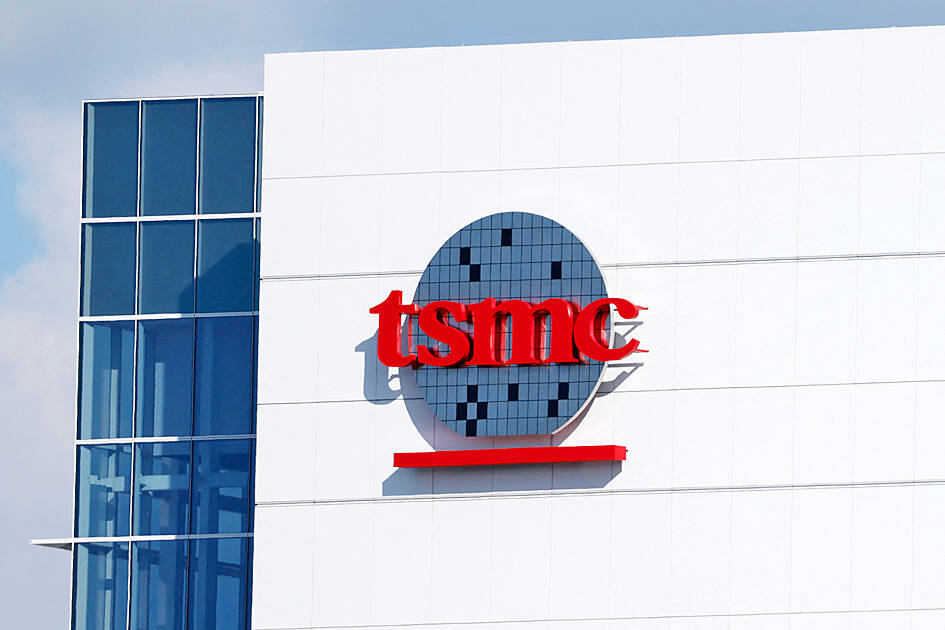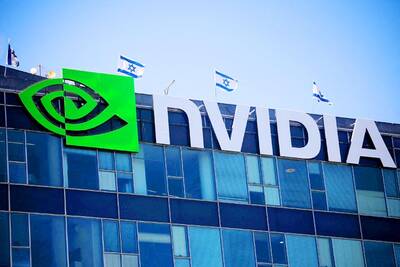Taiwan Semiconductor Manufacturing Co (TSMC, 台積電) further solidified its dominance in the global wafer foundry business in the first quarter of this year, remaining far ahead of its closest rival, Samsung Electronics Co, TrendForce Corp (集邦科技) said yesterday.
TSMC posted US$25.52 billion in sales in the January-to-March period, down 5 percent from the previous quarter, but its market share rose from 67.1 percent the previous quarter to 67.6 percent, TrendForce said in a report.
While smartphone-related wafer shipments declined in the first quarter due to seasonal factors, solid demand for artificial intelligence (AI) and high-performance computing (HPC) devices and urgent TV-related orders due to US tariff measures helped limit TSMC’s revenue decline in the quarter, it said.

Photo: Ann Wang, Reuters
In contrast, Samsung’s sales fell 11.3 percent sequentially to US$2.89 billion last quarter and its market share slid to 7.7 percent from 8.1 percent over the period, the report said.
TrendForce attributed Samsung’s falling sales to fewer benefits from China’s subsidy programs and the US’ export restrictions on advanced chips.
As a result, the gap between TSMC and Samsung widened to 59.9 percentage points last quarter from 59 percentage points a quarter earlier, it said.
TSMC shares closed up 1.01 percent at NT$1,005 yesterday, passing NT$1,000 for the first time since March 7, Taiwan Stock Exchange data showed.
The report also highlighted the Chinese chipmaker Semiconductor Manufacturing International Corp’s (SMIC, 中芯) rising competitiveness in mature nodes, as the firm posted increases in sales and market share.
SMIC remained third in the global foundry business, with revenue of US$2.25 billion, up 1.8 percent quarterly, and a market share of 6 percent, compared with 5.5 percent the previous quarter, the report said.
Its gap with Samsung narrowed to 1.7 percentage points last quarter from 2.6 percentage points three months earlier, it added.
United Microelectronics Corp (聯電) ranked fourth, with US$1.76 billion in revenue and a 4.7 percent market share, ahead of US-based GlobalFoundries Inc in fifth place, with a revenue of US$1.58 billion and a market share of 4.2 percent, it said.
In sixth to 10th places were Huahong Group (華虹) with US$1.01 billion in revenue and 2.7 percent market share, Vanguard International Semiconductor Corp (世界先進) with US$363 million and 1 percent market share, Tower Semiconductor Ltd with US$358 million and 0.9 percent share, NexChip Co (晶合集成) with US$353 million and 0.9 percent, and Powerchip Semiconductor Manufacturing Corp (力積電) with US$327 million and 0.9 percent, the report said.
The combined revenue of the top 10 wafer foundry companies fell 5.4 percent sequentially to US$36.4 billion last quarter due to seasonal weakness, although rush orders from clients and China’s consumer subsidies partially offset the slowdown in demand, TrendForce said.
For this quarter, the industry’s capacity utilization and revenue growth would be supported by China’s subsidy programs, the building of prelaunch inventories for new smartphone models, and stable demand for AI and HPC applications, although the effect of tariff-driven front-loading shipments are expected to fade for foundries.

Shares in Taiwan closed at a new high yesterday, the first trading day of the new year, as contract chipmaker Taiwan Semiconductor Manufacturing Co (TSMC, 台積電) continued to break records amid an artificial intelligence (AI) boom, dealers said. The TAIEX closed up 386.21 points, or 1.33 percent, at 29,349.81, with turnover totaling NT$648.844 billion (US$20.65 billion). “Judging from a stronger Taiwan dollar against the US dollar, I think foreign institutional investors returned from the holidays and brought funds into the local market,” Concord Securities Co (康和證券) analyst Kerry Huang (黃志祺) said. “Foreign investors just rebuilt their positions with TSMC as their top target,

H200 CHIPS: A source said that Nvidia has asked the Taiwanese company to begin production of additional chips and work is expected to start in the second quarter Nvidia Corp is scrambling to meet demand for its H200 artificial intelligence (AI) chips from Chinese technology companies and has approached contract manufacturer Taiwan Semiconductor Manufacturing Co (TSMC, 台積電) to ramp up production, sources said. Chinese technology companies have placed orders for more than 2 million H200 chips for this year, while Nvidia holds just 700,000 units in stock, two of the people said. The exact additional volume Nvidia intends to order from TSMC remains unclear, they said. A third source said that Nvidia has asked TSMC to begin production of the additional chips and work is expected to start in the second

REVENUE PERFORMANCE: Cloud and network products, and electronic components saw strong increases, while smart consumer electronics and computing products fell Hon Hai Precision Industry Co (鴻海精密) yesterday posted 26.51 percent quarterly growth in revenue for last quarter to NT$2.6 trillion (US$82.44 billion), the strongest on record for the period and above expectations, but the company forecast a slight revenue dip this quarter due to seasonal factors. On an annual basis, revenue last quarter grew 22.07 percent, the company said. Analysts on average estimated about NT$2.4 trillion increase. Hon Hai, which assembles servers for Nvidia Corp and iPhones for Apple Inc, is expanding its capacity in the US, adding artificial intelligence (AI) server production in Wisconsin and Texas, where it operates established campuses. This

US President Donald Trump on Friday blocked US photonics firm HieFo Corp’s US$3 million acquisition of assets in New Jersey-based aerospace and defense specialist Emcore Corp, citing national security and China-related concerns. In an order released by the White House, Trump said HieFo was “controlled by a citizen of the People’s Republic of China” and that its 2024 acquisition of Emcore’s businesses led the US president to believe that it might “take action that threatens to impair the national security of the United States.” The order did not name the person or detail Trump’s concerns. “The Transaction is hereby prohibited,”